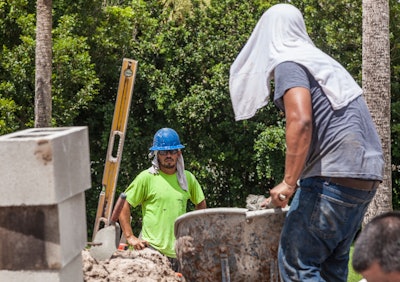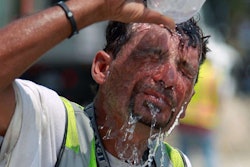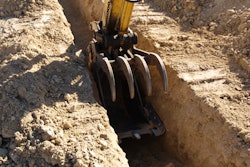
Editor's Note: This story was updated September 22, 2022.
Hot and humid summer days are right around the corner, and OSHA is cracking down on heat-related illnesses and injuries.
On April 12, the Department of Labor announced a new heat illness prevention campaign and enforcement program to protect workers, while continuing its long-term work to establish a federal heat standard.
As part of the program, OSHA will proactively initiate inspections in over 70 high-risk industries, including construction, when the National Weather Service has issued a heat warning or advisory for a local area. On days when the heat index is 80 degrees Fahrenheit or higher, OSHA inspectors and compliance specialists will visit workplaces to address heat hazards. As of July 20, the agency has conducted 564 workplace inspections for heat-related illness, according to the White House.
The safety campaign and forthcoming standard are top priorities for the Biden-Harris administration due to the disproportionate amount of minority, elderly and migrant workers affected by extreme heat and rising temperatures resulting from climate change.
According to findings from OSHA’s Advanced Notice of Proposed Rulemaking published last fall, construction had 13 times the risk of heat-related deaths than the average annual heat-related workplace fatality rate in all other industries, as well as the highest number of workers hospitalized for heat-related issues.
Currently, heat-related hazards are enforced under the general duty clause, Section 5(a)(1) of the OSH Act, but the administration says, “the lack of specificity in the General Duty Clause has created evidentiary hurdles for OSHA to issue citations and opened the agency to court challenges.”
In some cases, the lack of a specific heat standard led to the reversal of heat stress citations. OSHA would aim to make the new standard strict enough to withstand court challenges.
The Construction Industry Safety Coalition commented on the ANPRM, stating, “The CISC has significant concerns with any regulatory approach that imposes complicated requirements on contractors and requirements that are triggered by threshold temperatures that are common in wide swaths of the country for much of the year. Because the construction environment is ever-changing and fluid, any regulatory approach must be simple and adaptable.”
Considering construction was one of the industries called out specifically by OSHA, construction business owners should proactively update their heat emergency response plans and employee training programs.
Top heat safety myths
First, let’s clear up the most common myths related to heat safety, as noted in a recent webinar conducted by Magid:
Safety Plans Are One-Size-Fits-All
Using industry best practices as a foundation for a heat safety program is a good start, but plans should be individualized for the sector, geographic location, the intensity of the work being completed and your workforce demographics. Employers should have emergency procedures in place to treat heat stroke, or other heat-related injuries and illnesses, as well as regular heat safety training.
Just Drink Water
Adequate hydration alone will not prevent heat-related illnesses, but it is an important component. If workers are performing prolonged hours of work in the heat, it is important to make electrolyte-enhanced beverages available due to the physical demands and heat stress. If workers are not performing long hours of physical labor, or if it is not in the heat, water is a good option. Workers that consume a lot of sodium in their diet may not require additional electrolyte supplementation.
Shade is Enough
While shade is one heat-stress mitigation strategy, it may not be enough if temperatures are very hot and the physical demands of the work are intense and prolonged. Other tactics such as body cooling, hydration and environmental monitoring should be implemented to make sure workers are fully protected.
Tough it Out
The construction industry has reputation for telling workers to “man up,” but pushing through signs or symptoms of heat-related injuries and illnesses will only make things worse. Work to develop a culture where workers feel safe to speak up about their mental and physical condition.
Watch for Dry Skin
Dry skin is a sign of classic heatstroke that occurs in individuals with compromised cardiovascular systems, such as the elderly or infants. More commonly experienced on jobsites is exertion heat stroke, in which workers may be fully saturated in sweat. Pay close attention to workers who are exhibiting this symptom.
Heat Illness Only Happens on Hot, Sunny Days
While temperature is a factor, heavy exertion and insulating PPE can lead to heat-related injuries and illnesses even on mild days.
Several occupational and personal health factors can contribute to heat illness, including hot and humid environments, working in direct sunlight, working in confined spaces, heavy machinery throwing off additional heat, bulky or insulating clothing and personal protective equipment, medication or alcohol use, dehydration, underlying health conditions and a lack of heat-related emergency procedures and employer-initiated heat safety training.
The cost of neglecting heat safety
In addition to employee health concerns, there is a significant cost associated with heat-related incidents.
Recent OSHA figures suggest each incident will set an employer back nearly $80,000. By 2050, heat-induced labor productivity-loss costs in the U.S. could be as high as $500 billion annually, according to a study conducted by the Rockefeller Foundation.
“The most serious cases can result in significant or fatal organ damage, but even less severe cases can result in low heat tolerance,” says Magid Director of Health & Safety Matt Block. “Cooling interventions can help prevent some of the costs identified, but it also can potentially increase productivity by taking steps to improve performance.”
8 steps to prevent heat illness on construction sites
To mitigate risk to employees, the following components should be included in a heat safety program for your construction business.
1. Heat Hygiene: Educate and inform your team about measures to prevent and recognize heat illness, including day-to-day or even hour-to-hour communications and monitoring.
“One of the biggest things we recommend is having annual, as well as onboarding heat safety training,” says Margaret Morrissey, president of the National Heat Safety Coalition and director of occupational safety for the Korey Stringer Institute.
“Within this training, tell individuals what the risks are for heat-related illness, talk about what the treatment options are if someone is experiencing exertional heat stroke and make sure your workers are monitored at all times during extreme heat, especially if you have physically demanding work. Have a buddy system or supervisor who is able to recognize these signs and symptoms and be able to treat individuals appropriately.”
2. Hydration: Provide cool water and/or electrolyte-replacing beverages in close proximity to every worker.
“If the water station is a half-mile away it’s not going to be very effective, especially if the worker doesn’t get a lot of rest breaks,” says Morrissey.
Another thing to consider is easy access to restrooms. “A lot of times, an individual won’t have easy access to restrooms, and then because of that, they won’t drink. That’s really increasing their risk for heat illness and is something to think about.”
3. Heat Acclimatization: Ease new workers or workers returning from an extended absence into hot conditions gradually, increasing exposure slowly over a five- to seven-day period. Consider shifting work times to earlier or later in the day to avoid peak temperatures.
“When your workers come for their very first day of work, have them perform 20% of the work for the day and slowly increase that time and exposure to the heat. That will help them tolerate the heat better,” says Morrissey. “Heat-related illnesses and heat stroke typically happen within the first couple days of work because individuals aren’t used to physical demands in the heat.”
4. Environmental Monitoring: Beyond watching local weather forecasts, use a wet bulb globe temperature monitor to measure the humidity, temperature, wind and sun on your jobsite to determine which areas need additional heat safety measures.
“What the weather forecast tells you if you look it up on your watch or phone, is a number that can be drastically different from what it can be at your worksite,” says Block. “It’s critical to know what your microclimate is.”
5. Physiological Monitoring: Consider wearable monitors that can alert workers of risk factors like elevated skin temperature or heart rate that may indicate a risk of heat illness.
“Many employers are using this or thinking about it because they’re actually able to measure what their worker is experiencing,” says Morrissey. “The caveat being, there are a lot of physiological monitors out there that don’t actually measure what they’re intended to measure. Be sure to pick wearable devices that are shown to be validated in a research study.”
6. Body Cooling Stations: Provide cool areas, such as jobsite trailers, for resting at breaks and mealtimes. These should include cool drinks and coolers full of ice and towels for hydration and body cooling internally and externally.
7. Emergency Preparations: Teach the principles of “Cool First, Transport Second” in a heat illness emergency, including cold water immersion or application of ice and cold towels to cool the victim to a safe temperature before transportation to the hospital by EMTs.
“For exertional heat stroke, if you don’t get your body temperature down within 30 minutes, you’re at risk of organ damage,” says Morrissey. “A delay in treatment can lead to long-term complications, permanent complications or death.”
In a remote situation, use whatever methods you have available to cool the victim. Fill a tarp with water and ice and pull it up around the worker until emergency medical service providers arrive.
8. Cooling PPE: Provide body cooling PPE for workers to bring onto the jobsite that cool with any temperature of water and can be reactivated again and again for relief.
“Review your overall PPE to determine if there is any way you can make it lighter, more breathable or more comfortable,” says Adrianna Carrera, product management specialist, Magid.











